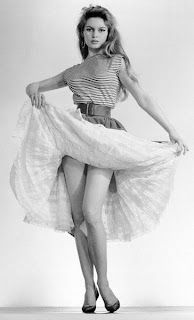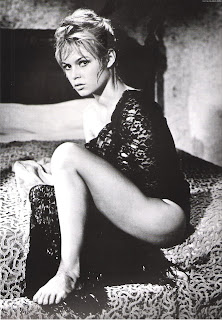 Brigitte Bardot
Brigitte Bardot
Brigitte Bardot Biography
Brigitte Bardot (full name is Brigitte Anne-Marie Bardot) was born in Paris to Anne-Marie 'Toty' Mucel and industrialist Charles 'Pilou' Bardot. Toty encouraged Brigitte's interest inmusic and dance at an early age; Brigitte modeled for Elle by the time she was 15 years old.
In 1952 Brigitte appeared on screen for the first time in Crazy for Love. That same year she married director Roger Vadim with whom she had been romantically involved for several years. They married when she turned 18 and divorced five years later.
Vadim was not content with this light fare. The New Wave of French and Italian art directors and their stars were riding high internationally, and he felt Bardot was being undersold. Looking for something more like an art film to push her as a serious actress, he showcased her in And God Created Woman (1956) with Jean-Louis Trintignant. The film, about an amoral teenager in a respectable small-town setting, was a big international success. She may have had an affair with her costar Trintignant but this was more likely a prerelease publicity gimmick. The film is often wrongly described as her first film (it was her seventeenth) and to have launched her overnight but it did help move her towards the cinematic mainstream.
She divorced Vadim in 1957 and in 1959 married actor Jacques Charrier, by whom in 1960 she had her only child, Nicolas-Jacques Charrier. She and her son were never close - she did not raise him and once compared being pregnant with him to having a tumor growing within her. Her marriage was preyed on by the paparazzi and there were clashes over the direction of her career. Her films became more substantial, but this brought a heavy pressure of dual celebrity as she sought critical acclaim while remaining a glamour model for most of the world.
Vie privée (1960), directed by Louis Malle has more than an element of autobiography in it. The scene in which, returning to her flat, Bardot's character is harangued in the lift by a middle aged cleaning lady calling her a tramp and a tart was based on an actual incident, and is a resonant image of celebrity in the mid 20th century.
In 1970 the sculptor Alain Gourdon used Bardot as the model for a bust of Marianne, the French national emblem.
In 1973 just before her fortieth birthday Bardot announced her retirement. After appearing in more than fifty motion pictures and recording several music albums, most notably with Serge Gainsbourg, she chose to use her fame to promote animal rights.
The first "Brigitte Bardot" song was released by Achilles and his Heels on the Fontana label in 1961.
In 1986 she established the Brigitte Bardot Foundation for the Welfare and Protection of Animals. She raised three million French francs to fund the foundation by auctioning off jewelry and many personal belongings. Today she is one of the world's most influential animal rights activists and a major opponent of the consumption of horse meat.
Considered a militant for animal protection, she condemned seal hunting in Canada during a visit to that country. She sought to discuss the issue with Stephen Harper, though her request for a meeting was denied.
Her husband Bernard d'Ormal to whom she has been married since 1992 is a former adviser of the Front National. With the publication of her 2003 book A Scream in the Silence the reclusive Bardot has come under considerable fire for anti-Muslim and homophobic comments. In May 2003 the MRAP announced it would sue Bardot for her published views. Another organisation - the "Ligue des Droits de l'Homme" (League of Human Rights) - announced they were also considering similar legal proceedings. To her defence, she never supported the Front National.
Bardot, in a letter to a French gay magazine, wrote in her defense: 'Apart from my husband - who maybe will cross over one day as well - I am entirely surrounded by homos.
On 10 June 2004 Bardot was convicted by a French court of 'inciting racial hatred and fined 5,000 €, the fourth such conviction/fine she has faced from French courts. The courts cited passages where Bardot referred to the "Islamization of France" and the "underground and dangerous infiltration of Islam", her descriptions of France's Muslim community, the largest in Europe. In the book she also referred to tranvestites as 'fairground freaks' and she questioned the presence of women in government.
In addition to popularizing the bikini swimming suit, Bardot has also been credited for popularizing Saint Tropez. Photos of her in her later years have also been utilized to warn against the dangers of excessive exposure to the sun.
In the Stephen King's book "Hearts in Atlantis", she is the one that appears on Bobby's mind when he and Ted see the big car outside the restaurant. She also appears on a wallpaper in a cinema.
Refrenced in the songs "We Didn't Start the Fire" (Billy Joel), "I Shall Be Free" (Bob Dylan), and "Warlocks" (Red Hot Chili Peppers).
Sem comentários:
Enviar um comentário